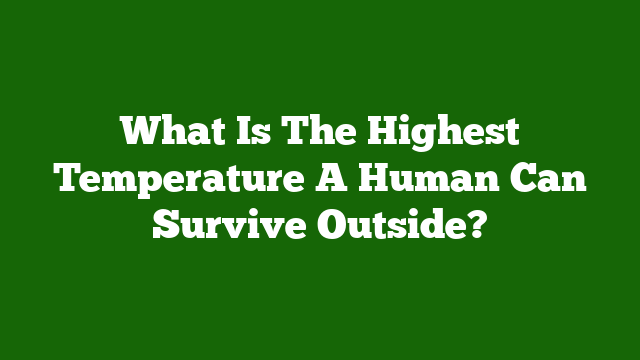Last Updated on June 12, 2023 by Umar
As the Earth’s climate continues to change, it’s important to understand the limits of human tolerance to high temperatures.
The highest temperature a human can survive outside depends on various factors, including humidity, access to water, and the duration of exposure.
Dry Air
In dry air conditions, humans can survive short-term exposure to temperatures of 120+ °C (248+ °F).
However, for long-term exposure, the survivable temperature drops to 70+ °C (158+ °F), provided there is access to water at cooler temperatures
Tropical Air
In tropical air conditions, where humidity is higher, the survivable temperature decreases to 60+ °C (140 °F)
Wet-Bulb Temperature
Wet-bulb temperature, which takes into account both heat and humidity, is a critical factor in determining survivability.
A wet-bulb temperature of 95 degrees Fahrenheit (35 degrees Celsius) is considered the limit for human survival, as higher humidity levels make it harder for sweat to evaporate and cool the body
Heat-Related Illnesses
Exposure to high temperatures can lead to various heat-related illnesses, such as heat cramps, heat exhaustion, and heatstroke
Heatstroke is a life-threatening condition that occurs when the body’s temperature control system fails, resulting in a core body temperature of 104 F (40 C) or higher
Symptoms of heatstroke include altered mental state, rapid breathing, racing heart rate, and headacheImmediate medical attention is necessary to prevent serious complications or death.
Acclimatization
Humans can adapt to heat stress through a process called acclimatization, which involves physiological adaptations such as increased sweating efficiency, stabilization of circulation, and improved skin blood flow
Gradually increasing exposure to hot environments over a 7-14 day period can help the body acclimatize
Preventing Heat-Related Illnesses
To reduce the risk of heat-related illnesses, it’s essential to stay hydrated, wear appropriate clothing, take breaks in cool or shaded areas, and avoid overexertion during high temperatures
Additionally, local governments can implement heat island reduction strategies, such as green or cool roofs and cool pavements, to help mitigate the effects of extreme heat
In conclusion, the highest temperature a human can survive outside depends on various factors, including humidity and the duration of exposure.
It’s crucial to be aware of the risks associated with high temperatures and take appropriate precautions to prevent heat-related illnesses.
Helpful Resources
- https://www.reddit.com/r/YouShouldKnow/comments/6kete0/ysk_what_is_the_highest_temperature_a_human_being/
- https://www.livescience.com/hottest-temperature-people-can-tolerate.html
- https://www.hopkinsmedicine.org/health/conditions-and-diseases/heatrelated-illnesses-heat-cramps-heat-exhaustion-heat-stroke
- https://www.mayoclinic.org/diseases-conditions/heat-stroke/symptoms-causes/syc-20353581
- https://www.cdc.gov/niosh/topics/heatstress/acclima.html
- https://www.cdc.gov/disasters/extremeheat/warning.html
- https://www.epa.gov/heatislands/adapting-heat

